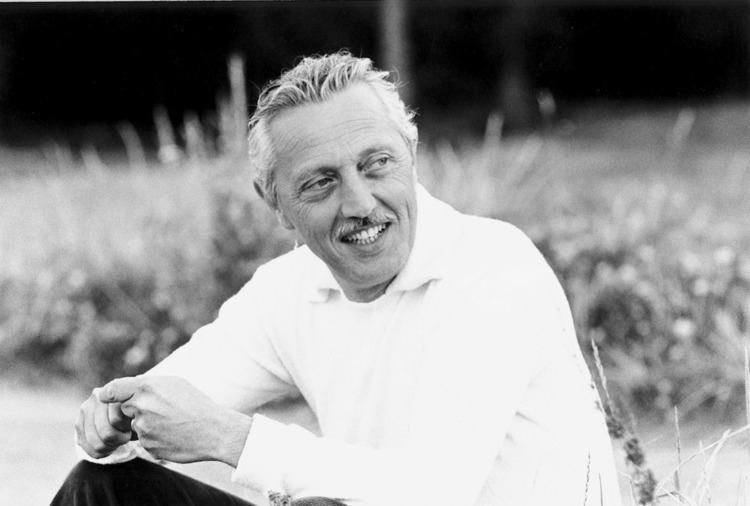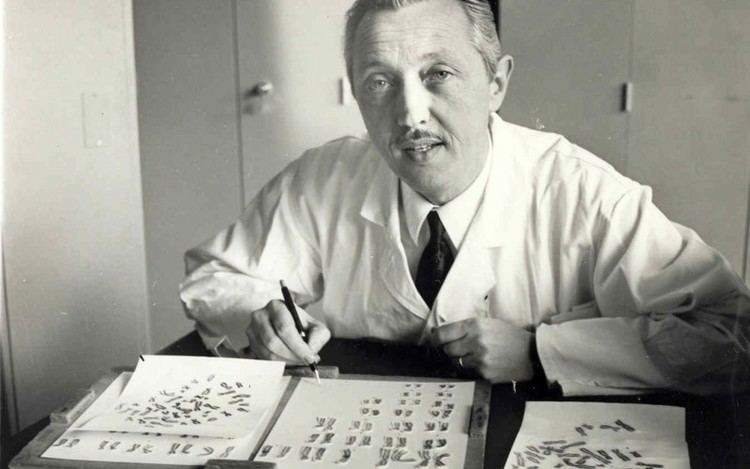Nationality French Fields PediatricsGenetics | Name Jerome Lejeune | |
 | ||
Born 13 June 1926Montrouge, Hauts-de-Seine, France ( 1926-06-13 ) Institutions French National Centre for Scientific Research Alma mater College Stanislas de ParisParis School of Medicine Notable awards Kennedy Prize (1962)William Allan Award (1969)Prix Griffuel 1992 at the Wayback Machine (archived January 17, 2008) | ||
Rencontre avec le professeur j r me lejeune pourquoi tes vous contre la pilule abortive
Servant of God Jérôme Jean Louis Marie Lejeune (13 June 1926 – 3 April 1994) was a French pediatrician and geneticist, best known for discovering the link of diseases to chromosome abnormalities and for his subsequent opposition to prenatal diagnosis and abortion.
Contents
- Rencontre avec le professeur j r me lejeune pourquoi tes vous contre la pilule abortive
- J r me lejeune une conscience pour la science d aujourd hui
- Discovering Trisomy 21
- Origins of the discovery
- Later research and recognition
- Pro life work
- Honors awards and credentials
- References
J r me lejeune une conscience pour la science d aujourd hui
Discovering Trisomy 21
In 1958, while working in Raymond Turpin’s laboratory with Marthe Gautier, Jérôme Lejeune reported that he had discovered that Down syndrome was caused by an extra copy of chromosome 21. According to Lejeune's laboratory notebooks he made the observation demonstrating the link on 22 May 1958. The discovery was published in French Academy of Sciences with Lejeune as first author, Gautier as second author and Turpin as senior author. In 2009 co-author Marthe Gautier claimed that the discovery was based on fibroblast tissue samples that she had prepared and noticed the discrepancy in chromosome count on. This discovery was the first time that a defect in intellectual development was shown to be linked to chromosomal abnormalities.
Origins of the discovery
In the early 1950s, Lejeune joined the department headed by Dr. Turpin, who suggested that Lejeune focus his research on the causes of Down syndrome. As early as 1953, the two men showed a connection between an individual’s characteristics and his or her dermatoglyphs—a term referring to fingerprints and lines on the hand. The structure of these lines, which remain the same throughout the individual's life, is determined during the earliest stages of embryo development. As Lejeune and Turpin studied the hands of children with Down syndrome, they deduced that their dermatoglyphic anomalies appeared during embryo formation. After making many more observations, Dr. Lejeune concluded that the anomalies resulted from a chromosomal accident. Using a new tissue culture technique brought back from the United States by his colleague Marthe Gautier, Lejeune began working with her to count the number of chromosomes in children with Down syndrome.

The laboratory notebook begun by Dr. Lejeune on 10 July 1957 indicates that on 22 May 1958 he succeeded in showing, for the first time, the presence of 47 chromosomes in a child with Down syndrome. This was only two years after Tjio and Levan had proven that the human species has 46 chromosomes. On 13 June 1958, Dr. Lejeune identified an additional case, and a photo of the karyotype met with skeptical interest at the International Congress of Genetics in Montreal. The international community did not grasp the full impact of his discovery until 26 January 1959, when the French Academy of Sciences published the team’s first paper presenting three case studies of children with Down syndrome.

On 16 March 1959, another presentation to the Academy of Sciences confirmed the team’s initial publication, this time covering nine cases. In April 1959, the English team of Brown and Jacobs corroborated these results, citing the initial January 1959 publication by Lejeune, Gautier, and Turpin. “Mongolism” had become Trisomy 21. The discovery opened up a new field of investigation for modern genetics and laid the foundation for a new discipline: cytogenetics.

Lejeune's colleague, Marthe Gautier, disputes his claim as the first discoverer of trisomy 21. She has stated in interviews and in a 2009 article in the journal Médecine Sciences that she worked without assistance from Lejeune to develop the necessary cytological and histological resources and techniques, and used these to prepare microscope slides showing the trisomy. By her account, Lejeune took her slides away under the pretence of having them photographed for her, but instead presented them as his own work at a conference and in a subsequent publication. From the available published evidence it is clear that both Lejeune and Gautier contributed significantly to the discovery, but it remains unclear who of both was first. In a personal letter from November 5, 1958 to Gautier, Lejeune wrote appreciatingly about 'your preparations' that were instrumental to the discovery, and Gautier appeared as co-author on two seminal papers: one on the discovery of trisomy 21 and a second one about the cell culture techniques that Gautier had learned during a scholarship (1955-1956) at Harvard, Boston which made the discovery possible.
Later research and recognition
Continuing his work in genetics, Lejeune described several other diseases related to chromosomal abnormalities. In 1963 he identified Cri du Chat Syndrome, caused by a missing segment in the short arm of chromosome 5, and in 1966 he described 18q-Syndrome, which results from loss of the distal portion of the long arm of chromosome 18. Lejeune also discovered the Dr phenotype (a malformation syndrome in which a ring-shaped chromosome replaces chromosome 13), and he identified trisomies on chromosome 9 in 1970 and chromosome 8 in 1971.
In a 1963 presentation before the French Academy of Sciences, Lejeune showed that monosomy—the absence of a specific segment of the genome—could also result in a clinically recognizable disease. Several years later, a group of American scientists came to Paris to conduct an independent investigation of Lejeune’s discovery, and in 1962 the President of the United States personally presented him with the Kennedy Prize. In 1964, the first chair of human genetics was created at the Paris School of Medicine, and Lejeune was named to fill it. The appointment was highly unusual: Only a groundbreaking discovery allowed a candidate to be named a professor of medicine without successfully completing a competitive residency examination.
In 1969, Lejeune's work earned him the William Allan Award, granted by the American Society of Human Genetics, the world’s highest honor in genetics. As of 2013 he was the only Frenchman to have won it.
Pro-life work
Although Lejeune’s discoveries paved the way for new therapeutic research into how changes in gene copy number could cause disease, they also led to the development of prenatal diagnosis of chromosome abnormalities and thence to abortions of affected pregnancies. This was very distressing to Lejeune, a staunch Catholic, and led him to begin his fight for the pro-life cause.
Lejeune opposed the authorization in 1967 for women to use contraception as well as the Peyret laws in 1970 to render legal the interruption of pregnancy in case of fetal abnormalities. He also opposed the Veil Law authorizing voluntary interruption of pregnancy. ("Loi Veil" 1975)
After receiving the Allan prize, Lejeune gave a talk to his colleagues which concluded by explicitly questioning the morality of abortion, an unpopular viewpoint in the profession. In a letter to his wife, Lejeune wrote "today, I lost my Nobel prize in Medicine". More likely, Lejeune's denial of the contribution of Marthe Gautier and Raymond Turpin to the discovery of trisomy 21 may have been more decisive for the Noble committee to avoid a contested laureate.
In 1975, after one of his public appearances in Paris on the beginning of life, Lejeune met Dr. Wanda Poltawska, director of the Catholic Institute for the Family in Krakow. Later that year, Poltawska contacted Lejeune twice, asking him to speak at conferences on the beginning of life that she was organizing with one of her close friends, Monsignor Karol Wojtyla, then Cardinal-Archbishop of Krakow. On 16 October 1978 Wojtyla was elected Pope John Paul II.
Afterward, Lejeune regularly traveled to Rome to meet with the Pope, to attend meetings of the Pontifical Academy of Sciences, and to participate in other church events, such as the 1987 Synod of Bishops. The Pope wanted to name Lejeune as the president of a new pontifical academy that was dear to his heart: the Pontifical Academy for Life. Lejeune painstakingly drafted its bylaws and the oath of the Servants of Life that each member of the Academy must take.
Lejeune was diagnosed with lung cancer in November 1993. He served as President of the Academy for only a few weeks before his death in April 1994.
A few years later, during his visit to Paris for World Youth Day 1997, John Paul II visited Lejeune’s grave in Châlo-Saint-Mars. Lejeune has been named "Servant of God" by the Catholic Church, and his cause for sainthood is being postulated by the Abbey of Saint Wandrille in France.
Honors, awards and credentials
Jérôme Lejeune received many distinctions during his lifetime. He was a member of:
Dr. Lejeune held honorary doctorates from:
His international positions included:
Consulting expert on human genetics (1962)
Committee member (1963)
French expert to the Scientific Committee on the Effects of Atomic Radiation
